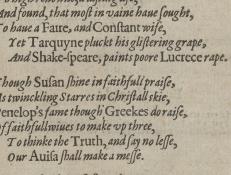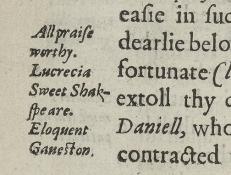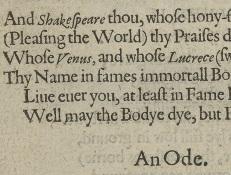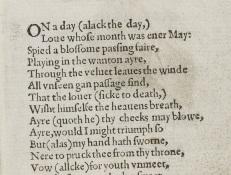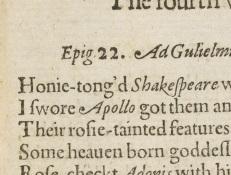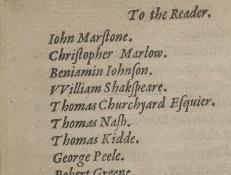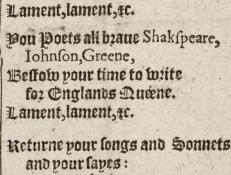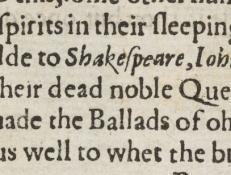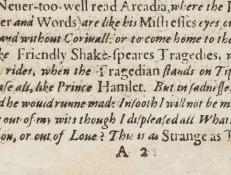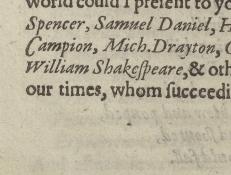To view a sortable list, please visit the Resource
All Documents
1594
The first known printed reference to Shakespeare appears in a commendatory poem introducing the poetry collection Willobie his Avisa, printed in 1594. The poem, entitled “In praise of Willobie his Avisa, Hexameton to the Author,” appears before the main text.
1595
In 1595 William Covell, a church of England clergyman and a fellow of Queen’s College in Cambridge, wrote Polimanteia, which was produced by John Legate, the Cambridge University printer.
1598
In “A Remembrance of some English Poets,” the poet Richard Barnfield praises Edmund Spenser, Samuel Daniel, Michael Drayton, and Shakespeare.
1599
This is a fragment of the only surviving copy of the first edition of The Passionate Pilgrim (1599). An early owner bound it with other poetic works, including a 1600 edition of Shakespeare's Lucrece and the only surviving copy of the sixth editi
1599
John Weever’s Epigrammes in the oldest cut, and newest fashion was published in 1599. Weever began his career as an aspiring poet and literary observer at Cambridge, where he was the student of William Covell at Queen’s College.
1600
Like other plays from the period, Shakespeare's plays were meant to be read both as stories and as sources for sententiae, or memorable aphorisms.
1603
SHAKESPEARE DOCUMENTED IS STILL GROWING! Descriptive content and transcriptions will continue to be added, updated and expanded. Check back for regular updates!
1604
SHAKESPEARE DOCUMENTED IS STILL GROWING! Descriptive content and transcriptions will continue to be added, updated and expanded. Check back for regular updates!
1604
In 1604, Thomas Creede printed a volume of poetry called "Daiphantus, or the Passions of Love" for publisher William Cotton. The author is identified on the title page as "An.
1605
In 1587 William Camden (1551-1623), one of England’s most respected antiquaries, published his Britannia (ESTC), first in Latin, and then, beginning in 1610, in English.

